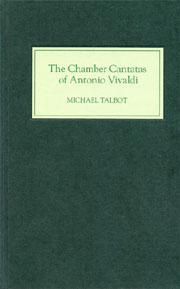Book contents
- Frontmatter
- Contents
- List of music examples
- List of tables
- Preface
- Conventions and abbreviations
- 1 The Rediscovery of Vivaldi's Cantatas
- 2 The Cantata Genre
- 3 Vivaldi and the Voice
- 4 The Mantuan Cantatas
- 5 Cantatas of the Middle Years
- 6 The Dresden Cantatas
- 7 Vivaldi's Cantatas in Perspective
- Glossary
- List of Vivaldi's cantatas published in the New Critical Edition
- Spurious works
- Bibliography
- Index to musical works
- General index
2 - The Cantata Genre
Published online by Cambridge University Press: 12 September 2012
- Frontmatter
- Contents
- List of music examples
- List of tables
- Preface
- Conventions and abbreviations
- 1 The Rediscovery of Vivaldi's Cantatas
- 2 The Cantata Genre
- 3 Vivaldi and the Voice
- 4 The Mantuan Cantatas
- 5 Cantatas of the Middle Years
- 6 The Dresden Cantatas
- 7 Vivaldi's Cantatas in Perspective
- Glossary
- List of Vivaldi's cantatas published in the New Critical Edition
- Spurious works
- Bibliography
- Index to musical works
- General index
Summary
Its Historical Development
Much confusion is liable to arise from the fact that a generic label applied to musical compositions (sonata, symphony, cantata, etc.) as part of their title is rarely perfectly coextensive with the same word operating as a modern historical or analytical category. In other words, some pieces originally entitled ‘cantata’ manifest a set of characteristics untypical of the genre – to the extent that one may perhaps wish to exclude them altogether from discussion – whereas, conversely, other pieces not so titled may display cantata characteristics in abundance and legitimately be taken into account. In the opening volume of his history of what he termed ‘the sonata idea’ William S. Newman adopted a so-called semantic approach designed to produce ‘the history of a single term, by whatever principles it might be governed’. Such an approach has the virtues of clarity and expediency, but is in the end less rewarding than one based on musical realities rather than on a choice of title that may be arbitrary, whimsical, or even inauthentic. On the other hand, these musical realities must not be conceived too inflexibly. Probably the best basis for assigning a work to a generic category is its conformity to most – but not necessarily all – items in a list of criteria, in which the generic title appears only as one item among several.
- Type
- Chapter
- Information
- The Chamber Cantatas of Antonio Vivaldi , pp. 25 - 60Publisher: Boydell & BrewerPrint publication year: 2006



